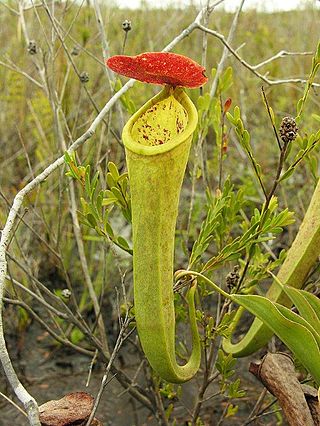Spondianthus is a genus of plant, in the family Phyllanthaceae and is the only genus comprised in the tribe Spondiantheae. It was first described as a genus in 1905. The genus contains only one recognized species, Spondianthus preussii, widespread across much of tropical Africa from Liberia to Mozambique.
- Spondianthus preussii subsp. glaber(Engl.) J.Léonard & Nkounkou – from Nigeria to Tanzania south to Angola; also Guinea, Ivory Coast
- Spondianthus preussii subsp. preussii – from Liberia to Zaire

Schinopsis balansae is a hardwood tree known as willow-leaf red quebracho which forms forests in the subtropical Humid Chaco ecoregion of north-eastern Argentina, and Paraguay. It is also found in the wild Pantanal vegetation in Brazil. Some of its vernacular names are quebracho colorado chaqueño and quebracho santafesino. Other species, like Schinopsis lorentzii, bear the general name quebracho and have similar properties and uses. S. balansae shares its habitat with a species of the same genus, S. heterophylla, and the two are often confused.

Intsia bijuga, commonly known as Borneo teak, Johnstone River teak, Kwila, Moluccan ironwood, Pacific teak, scrub mahogany and vesi, is a species of flowering tree in the family Fabaceae, native to the Indo-Pacific. It ranges from Tanzania and Madagascar east through India and Queensland, Australia, Papua New Guinea to the Pacific islands of Fiji and Samoa. It grows to around 50 metres tall with a highly buttressed trunk. It inhabits mangrove forests. Intsia bijuga differ from Intsia palembanica in the number of leaflets that make up their compound leaves.

Nepenthes tenax is a lowland species of tropical pitcher plant native to northern Queensland, Australia. It is the third Nepenthes species recorded from the continent and its second endemic species. Nepenthes tenax is closely related to the three other Australian Nepenthes species: N. mirabilis, N. rowaniae and N. parvula.
The Cameroon soft-furred mouse or Cameroon praomys is a species of rodent in the family Muridae. It is found in Cameroon and Equatorial Guinea. Its natural habitat is subtropical or tropical moist montane forests. It is threatened by habitat loss.
Eugenia fernandopoana Engl. & Brehmer, Bot. Jahrb. Syst. 54:337,1917, is a species of plant in the family Myrtaceae. It is found in Cameroon, Central African Republic, and Equatorial Guinea. Its natural habitat is subtropical or tropical moist lowland forests. It is threatened by habitat loss.
Isolona dewevrei is a species of plant in the Annonaceae family. It is endemic to the Democratic Republic of the Congo. It is threatened by habitat loss.
Nothofagus nuda is a species of plant in the family Nothofagaceae. It is endemic to Papua New Guinea. It is threatened by habitat loss.
Vepris suaveolens, synonym Oricia suaveolens, is a species of plant in the family Rutaceae. It is found in Cameroon, the Central African Republic, the Democratic Republic of the Congo, Ivory Coast, Ghana, Guinea, Liberia, Nigeria, and Sierra Leone. It is threatened by habitat loss.

Aristolochia goldieana is a species of plant in the family Aristolochiaceae. It is found in Benin, Cameroon, Ghana, Guinea, Guinea-Bissau, the Gulf of Guinea Islands, Ivory Coast, Liberia, Nigeria, and Sierra Leone. Its natural habitat is subtropical or tropical moist lowland forests. It is threatened by habitat loss.
Aristolochia preussii, synonym Pararistolochia preussii, is a species of plant in the family Aristolochiaceae. It is native to Cameroon, Equatorial Guinea, Gabon, and Ivory Coast. Its natural habitat is subtropical or tropical dry forests. It was assessed as "critically endangered" and threatened by habitat loss in the 2000 IUCN Red List, where it is said to be native only to Cameroon. As of February 2023, Plants of the World Online gives it a wider distribution.
Schinus pearcei is a species of plant in the family Anacardiaceae. It is found in Bolivia, Chile, and Peru.
Trichoscypha cavalliensis is a species of plant in the family Anacardiaceae. It is found in Ivory Coast, Ghana, and Liberia. It is threatened by habitat loss.
Trichoscypha mannii is a species of plant in the family Anacardiaceae. It is found in Cameroon, Ivory Coast, Ghana, Liberia, and Nigeria. It is threatened by habitat loss.

Buchanania obovata is a small to medium-sized understorey tree in woodlands native to northern Australia, in particular in Arnhem Land in the Northern Territory. Common names include green plum and wild mango.

Searsia longipes is a medium-sized, semi-deciduous, trifoliate tree of up to 10 m tall. It occurs in Africa from Burkina Faso to South Africa, as well as the islands of the Indian Ocean.
Pierrina is a monotypic genus of flowering plants belonging to the family Lecythidaceae. It only contains one known species, Pierrina zenkeriEngl.
Lannea microcarpa is a dioecious plant within the Anacardiaceae family. It is also called African grapes and occurs in the Sudan and Guinea savanna of West Africa from Senegal to Cameroon. The plant is used to dye basilan fini, a traditional cloth in a red and brown colour.
Trichoscypha acuminata, commonly called amvout, is a species of plant in the family Anacardiaceae. It is found in Nigeria, Cameroon, Equatorial Guinea, Central African Republic, Gabon, the Congos and Angola. Mature trees reach 20m in height and leaves are up to 1.5m long. Its natural habitat is rain forest. Fruits are dark red and edible.
Trichoscypha oddonii, common name mbuta, is a species of plant in the family Anacardiaceae. It is found from Cameroon to the Congos and northern Angola. Mature trees reach 26m in height and leaves are up to 2.5m long. It is very similar to Trichoscypha acuminata in all characteristics, with the fruit being a little more acidic.






